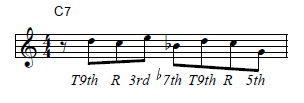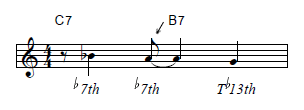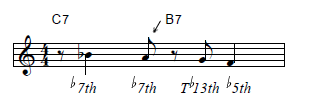- Some principles in Jazz musical analysis (1)
- Melody Analysis
- An Avoid Note
- A Passing Note
- An Approach Note
- A Double Approach Note
- Anticipation
- Steps required for a good musical analysis
- How to get the correct mode scale with no screw-ups
- Harmonic Rhythm
- Compounf Chords
- Download the best scores and sheet music transcriptions from our Library.
- And now, lte’s listen to some beautiful Jazz & Blues Music: Blue Note Trip-Swing Low Fly High Full Album CD1
- TRACKLIST:
Some principles in Jazz musical analysis (1)
Melody Analysis
Analyzing melody is done by numbering each note according to the mode (C Mixolydian, in this example).

An Avoid Note
In this example, the 4th note is the Avoid Note to the Mixolydian. Therefore, it will be marked as (4), which indicates it is one of the Scale
Notes.

The definition of the Avoid Note is:
1) Do not start with.
2) Do not hold with.
3) Do not end with.
A Passing Note

Passing Note is a note located between the notes from the mode. A Passing Note must be preceded by a 1/2 step, and followed by a 1/2 step
as well. Note that D# in this example is not T#9th because the Passing Note function is obvious.
An Approach Note

An Approach Note , unlike a Passing Note, is a note that is followed by a note from the mode by a 1/2 step. Note that D# in this example is not T#9th because the Approach Note function is obvious.
A Double Approach Note

A Double Approach Note is a note that is followed by an Approach Note. Note that a Double Approach note must have the opposite direction
of an Approach Note by a whole step.
Anticipation

Anticipation is defined by a value smaller than the beat value (i.e., Quarter Note in 4/4). In this first example, if the note A is a quarter note placed on 2 instead of an 8th note on the end of 2, it becomes T13th against C7, and will be changed to b7th on beat 3 even though the note is tied over.

The second example shows that the Anticipation appears followed by a rest. It is easier if the imagination is used to hear the ring of the note over the rest.
Steps required for a good musical analysis
- Arrow and Bracket Analysis, and the Key of the Moment indication with the box.

2. Roman Numeral Analysis and Mode (Scale) Analysis.

3. Indication for M.I.(Modal Interchange) and/or D.R.(Deceptive Resolution) if applicable.

4. Scale Degree Analysis.

How to get the correct mode scale with no screw-ups

Let’s find the correct scale for Eb Aeolian using the chart above.
First, write out the notes across an octave from E to D (ignore the b at this point).

Next, using the chart above, find the Parent key for Eb Aeolian. The Aeolian is located at the Major 6th above the Parent key. You will get Gb Major going down a Major 6th from Eb as the Parent key.
Apply the key signature of Gb Major to the scale above. The key signature for Gb Major is Bb-Eb-Ab-Db-Gb-Cb.

This is the Eb Aeolian scale. Easy, Isn’t it?!
Harmonic Rhythm
Harmonic Rhythm is a division line in music that evenly divides the section. I.e., a 32 bars music form is divided in 16 bars x 2, the 16 bars section will be divided in 8 bars x 2, the 8 bars section….., a measure in 4/4 is divided in 2 beats x 2…, and so on.
• Harmonic Rhythm creates a sense of section which affect melody as well as chord changes.
• Note that the Blues form differs in division. The 12 bars form could have been divided into 6 bars each, but the 6 bars section cannot be divided into 3 bars each because it is an odd number. Therefore,
the Harmonic Rhythm in a 12 bars Blues form is 4 bars x 3.
• In most of the standard jazz music, which written in a 32 bars form, the Harmonic Rhythm subdivision is 8 bars x 4, because most common form styles are “A-A-B-A” and “A-B-A-C”.

Compounf Chords
Inversion is a chord with the bass which is replaced with a chord tone other than the root.

Hybrid is a chord with a bass which is other than any of chord tones. Note that the any kind of 3rd against the bass can not be included in the upper structure chord, because it will characterize a chord to the bass. Basically, the upper structure chord is derived from the scale notes against the bass. However, because the 3rd of the bass is not included, ambiguous sound will be created.

1) Derived from D Dorian with b7, 9, 11, and 13 those which create the upper structure chord. Since the b3rd (F) is missing from this chord, it will not sound D-7. It rather sounds C Maj7 with the 9th on the bass.
2) Derived from G Mixolydian with 5, b7, 9 and S4. Note that the avoid note (S4: C) can be used because the 3rd (B) is missing from this chord. The sound will be D-7 with the 11th on the bass.
3) Derived from # Locrian with 11, b7 and S2(b9). Note that the flat 9th interval created derived from D# between D and E is acceptable in two reasons. The one is because Locrian is a semidominant functioning mode, so as altered dominant tensions are, flat 9th interval will create more resolution sense. The other is because the upper structure chord creates strong unity as a chord, the ear can separate it from the bass. However, the caution must be taken when it is used.
Polychord is a chord combined with two triads or 7th chord. Usually, the upper structure is created from the available tensions of the bottom chord. This is extremely useful when the key-board voicing is needed to be specified for ensemble arranging reasons.

Download the best scores and sheet music transcriptions from our Library.
Ben Webster and The Oscar Peterson Trio LIVE in Hannover (1972) – “COTTON TAIL” JAZZ MASTERS
Track List:
0:00 Poutin 8:12 Sunday 15:30 I Got It Bad and That Ain’t Good 23:15 Perdido 31:21 Come Sunday 39:01 For All We Know 49:43 Cottontail
Browse in the Library:
Or browse in the categories menus & download the Library Catalog PDF:
